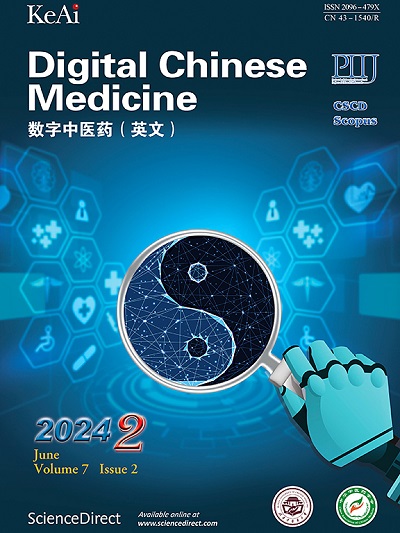通过分子对接、动力学模拟和ADMET分析,桃干植物化学物质对革兰氏阳性和革兰氏阴性细菌的多靶点抑制特性
Q3 Medicine
引用次数: 0
摘要
目的通过分子对接(MD)和实验验证,评价水仙桃(pericaria hydropiper, P. hydropiper)活性化合物对细菌毒力蛋白的抑菌活性。方法对水椒中6种活性成分:儿茶素(CAT1)、金丝桃苷(HYP1)、麻豆苷(OMB1)、松木素(PSV1)、槲皮素3-硫酸酯(QSF1)和灯叶苷(SCR1)进行研究。利用蛋白数据库(Protein Data Bank identifiers, PDB ID)对四种细菌靶蛋白的结合亲和力和潜在结合袋进行了MD评估:大肠杆菌(E. coli)的拓扑异构酶IV (PDB ID: 3FV5)、金黄色葡萄球菌(S. aureus)的旋切酶ATPase结合域(PDB ID: 3U2K)、紫色色杆菌(C. violaceum)的CviR (PDB ID: 3QP1)和铜绿假单胞菌(P. aeruginosa)的糖基水解酶(PDB ID: 5BX9)。对最有前途的化合物-蛋白质复合物进行了50纳秒(ns)的分子动力学模拟(MDS)。采用Lipinski's Rule of Five (RO5)评估药物相似性,然后使用SwissADME和pkCSM web服务器进行吸收、分布、代谢、排泄和毒性(ADMET)分析。通过圆盘扩散试验评估抗菌活性,测试单个化合物和与常规抗生素[头孢噻肟(CTX1, 30 μg/盘),头孢他啶(CAZ1, 30 μg/盘),哌拉西林(PIP1, 100 μg/盘)]的联合。结果CAT1与3QP1 (- 9.3 kcal/mol)和5BX9 (- 8.4 kcal/mol)具有较强的结合亲和力(- 9.3 ~ - 5.9 kcal/mol)。MDS证实了cat1蛋白复合物的稳定性,结合自由能分别为- 84.71 kJ/mol (5BX9-CAT1)和- 95.59 kJ/mol (3QP1-CAT1)。5个化合物(CAT1、SCR1、PSV1、OMB1和QSF1)符合Lipinski’s RO5,并显示出良好的ADMET谱。所有化合物均无致癌性,CAT1属最低毒性类(VI)。在抗菌试验中,CAT1对革兰氏阳性菌[肺炎链球菌(S. pneumoniae)、金黄色葡萄球菌和蜡样芽孢杆菌(B. cereus)][抑制区直径(ZDI): 10 - 22 mm]和革兰氏阴性菌[鲍曼不动杆菌(A. baumannii)、大肠杆菌和铜绿假单胞菌](ZDI: 14 - 27 mm)均有显著活性。CAT1与抗生素联用有协同作用,生长抑制指数(GII)为0.69 ~ 1.00。水胡椒生物活性化合物,特别是CAT1,通过多种机制显示出良好的抗菌潜力,包括直接抑制细菌毒力蛋白和与传统抗生素的协同活性。其良好的药理特性和低毒性特性支持其作为细菌感染治疗剂的潜在发展。本文章由计算机程序翻译,如有差异,请以英文原文为准。
Multi-target inhibition property of Persicaria hydropiper phytochemicals against gram-positive and gram-negative bacteria via molecular docking, dynamics simulation, and ADMET analysis
Objective
To evaluate the antibacterial potential of bioactive compounds from Persicaria hydropiper (L.) (P. hydropiper) against bacterial virulence proteins through molecular docking (MD) and experimental validation.
Methods
Six bioactive compounds from P. hydropiper were investigated: catechin (CAT1), hyperin (HYP1), ombuin (OMB1), pinosylvin (PSV1), quercetin 3-sulfate (QSF1), and scutellarein (SCR1). Their binding affinities and potential binding pockets were assessed through MD against four bacterial target proteins with Protein Data Bank identifiers (PDB IDs): topoisomerase IV from Escherichia coli (E. coli) (PDB ID: 3FV5), Staphylococcus aureus (S. aureus) gyrase ATPase binding domain (PDB ID: 3U2K), CviR from Chromobacterium violaceum (C. violaceum) (PDB ID: 3QP1), and glycosyl hydrolase from Pseudomonas aeruginosa (P. aeruginosa) (PDB ID: 5BX9). Molecular dynamics simulations (MDS) were performed on the most promising compound-protein complexes for 50 nanoseconds (ns). Drug-likeness was evaluated using Lipinski's Rule of Five (RO5), followed by absorption, distribution, metabolism, excretion, and toxicity (ADMET) analysis using SwissADME and pkCSM web servers. Antibacterial activity was evaluated through disc diffusion assays, testing both individual compounds and combinations with conventional antibiotics [cefotaxime (CTX1, 30 μg/disc), ceftazidime (CAZ1, 30 μg/disc), and piperacillin (PIP1, 100 μg/disc)].
Results
MD revealed strong binding affinity (ranging from – 9.3 to – 5.9 kcal/mol) for all compounds, with CAT1 showing exceptional binding to 3QP1 (– 9.3 kcal/mol) and 5BX9 (– 8.4 kcal/mol). MDS confirmed the stability of CAT1-protein complexes with binding free energies of – 84.71 kJ/mol (5BX9-CAT1) and – 95.59 kJ/mol (3QP1-CAT1). Five compounds (CAT1, SCR1, PSV1, OMB1, and QSF1) complied with Lipinski's RO5 and showed favorable ADMET profiles. All compounds were non-carcinogenic, with CAT1 classified in the lowest toxicity class (VI). In antibacterial assays, CAT1 demonstrated significant activity against both gram-positive bacteria [Streptococcus pneumoniae (S. pneumoniae), S. aureus, and Bacillus cereus (B. cereus)] [zone diameter of inhibition (ZDI): 10 – 22 mm] and gram-negative bacteria [Acinetobacter baumannii (A. baumannii), E. coli, and P. aeruginosa] (ZDI: 14 – 27 mm). Synergistic effects were observed when CAT1 was combined with antibiotics and the growth inhibitory indices (GII) was 0.69 – 1.00.
Conclusion
P. hydropiper bioactive compounds, particularly CAT1, show promising antibacterial potential through multiple mechanisms, including direct inhibition of bacterial virulence proteins and synergistic activity with conventional antibiotics. The favorable pharmacological properties and low toxicity profiles support their potential development as therapeutic agents against bacterial infections.
求助全文
通过发布文献求助,成功后即可免费获取论文全文。
去求助
来源期刊

Digital Chinese Medicine
Medicine-Complementary and Alternative Medicine
CiteScore
1.80
自引率
0.00%
发文量
126
审稿时长
63 days
期刊介绍:
 求助内容:
求助内容: 应助结果提醒方式:
应助结果提醒方式:


